Waverley History | 1910 - 1919
1912
The Southern portion of Waverley property is redesigned by the Olmsted Brothers out of Brookline, Massachusetts. On December 13th, the Waverley Board accepts a trophy from C.H. Davis, Jr. to serve as the perpetual trophy for the Seattle—Waverley team matches.
All business and financing of the Golf Club had been managed by the Waverly Association. In 1912, it disbanded and ordered the Secretary to register (with the city of Portland) the newly organized club—known from that day forward as the Waverley Country Club. To differentiate it from Waverly Golf Club, the same name could not be used so an ‘e’ was added, and the spelling thereafter became “Waverley”.
The acreage was surveyed in preparation for rerouting the course to allow for a new driveway, the construction and relocation of a new clubhouse and pro shop, the polo field, four tennis courts, stables and a boat dock. Later, a swimming pool and dressing rooms were added.
The polo field was put to immediate use. Waverley fielded both a Red and a Blue team. They held matches between the Ft. Vancouver barracks teams along with other Washington and Idaho clubs. Reporting on the early matches, The Oregonian indicated the Waverley teams were not easily beaten.
1911
The list of founding members is again expanded to include William Mackintosh, James D. Hart, Hugh Wallace, C.W. Hallamore, Peter Kerr and Thomas Kerr.
1912
FIRST INTERSTATE MAIL DELIVERY LANDS AT WAVERLEY
The Waverley polo field was the site of a unique and historic event in August of 1912 when aviator Walter Edwards completed the first interstate mail delivery in a Curtiss Pusher type biplane. The flight departed from the Waverley polo field, flew over the course, up the Willamette River, over Portland, across the Columbia River and landed at the field at Fort Vancouver. This two-day historic event delivered over 5,000 pieces of Airmail, including letters to U.S. Presidents William Taft, Teddy Roosevelt and Woodrow Wilson as well as the Postmaster General. Letters were postmarked U.S. Aeroplane Mail Service. The temporary Postal Station at Waverley, called Portland Aviator Station No. 1, was the first interstate airmail postal station in the United States.

- Born: April 26, 1822 – Hartford, Connecticut
- Died: August 28, 1903 – Belmont, Massachusetts
- Major Projects: Central Park (New York City), The Biltmore Estate (Asheville, NC),
- University of California (Berkeley, CA), Stanford University (Palo Alto, CA), landscaping surrounding the U.S. Capitol Building (Washington, D.C.)
Olmsted has been called "the founder of American landscape architecture and the nation's foremost park-maker" by the National Park Service. Olmsted was born into a well-to-do family and dabbled in various professions until being appointed superintendent of Central Park during the park's design phase in 1857. With fellow designer Calvert Vaux, he designed the 843-acre park and oversaw its early development. Central Park was a tremendous success, and established the themes which are now closely associated with Olmsted, especially his use of hills, trees and curved walkways to give visitors intriguing vistas and a feeling of serene isolation from the city. Olmsted and Vaux later formed a partnership and designed Brooklyn's Prospect Park as well as major parks in Buffalo, Louisville and elsewhere. Olmsted founded his own firm in 1883 in Brookline, Massachusetts and conceived Boston's "Emerald Necklace" of green spaces. Among his many other projects, he played a major role in the 1870s redesign of the U.S. Capitol grounds and in the design of the 1893 Chicago World's Fair. Olmstead retired in 1895 and his firm was taken over by his sons, Frederick Law Olmsted Jr. and John Charles Olmsted.

Discussions of a new clubhouse stirred controversy. The Olmsted Brothers had previously worked in Portland on the design of the 1905 Lewis & Clark Exposition. They were retained by the Board. The firm had impeccable credentials, having designed numerous iconic sites, including Central Park in New York, the mall in Washington, D.C. and the White House grounds. Frederick Law Jr. was the designer of the Jefferson Memorial in Washington, D.C. The Olmsted Brothers designed the new road and landscaping surrounding the Waverley property and clubhouse.
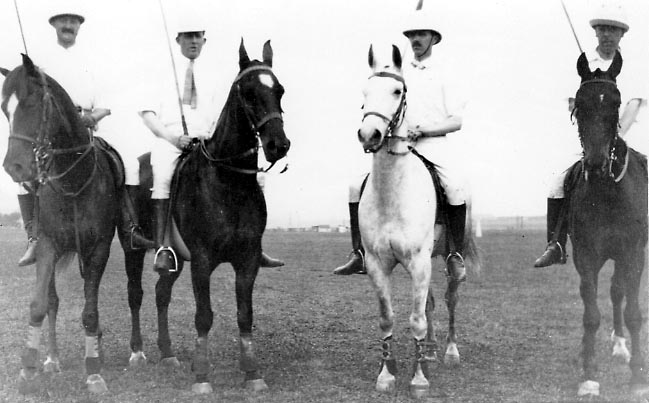
Those designs, which included recommendations for the clubhouse location, met with opposition from Waverley’s polo playing members. Polo enthusiasts, including team captain Gordon Voorhies, wanted the clubhouse to be located south of the current location so members could view matches directly from the clubhouse. The Olmstead Brothers recommended a location somewhat North of where the clubhouse is located today on a slight rise of land that would give members a greater view of the course, north and south, as well as better river vistas. A compromise was reached that sited the building at the north edge of what was then the polo field. Today, the old polo field is the site of Waverley’s driving range. The original pro shop was called the “field house”, a reference which continued when the new pro shop was built. Memorabilia of Waverley’s polo heritage is on display in the field house.
The Portland architectural firm of Whitehouse and Fouiloux were hired to design the new clubhouse. Waverley’s 1912 Board of Directors sought an elegant but understated look. Whitehouse and Fouiloux responded by designing a classic Dutch Colonial Revival building. The building features white shingled siding, gambrel roof, porticos supported by simple Tuscan column, multi-light double hung windows, beveled and leaded glass door elements and a lengthy river view balcony with balustrades. The Olmstead Brothers landscape plan was implemented to support and compliment the architectural design. The cost of the clubhouse was $72,000. An additional $13,500 was contracted to the firm of Davenport of Boston for furnishings. A committee of Waverley women assisted with the internal décor which followed the current style and comfort of the time.
As the clubhouse was being constructed, stables were erected at the south end of the polo field in what is today the south practice range. The cost of the stables was $4,295. An additional $47,000 was spent on the road into the club grounds, tennis courts, lockers, lighting fixtures and architectural fees. The club hired C. C. Colburn to implement the landscape design for a fee of $3,000. Information on the fees paid to Olmstead Brothers cannot be found.
Originally, the men’s locker room was located in the basement of the new clubhouse. It included a bar and men’s lounge with 350 lockers. As it remains today, the women’s locker room was upstairs with lockers and spacious dressing rooms.
Initially, the clubhouse had single and double sleeping rooms for rent by single male members. During World War I, the rented rooms were closed to reduce club expense. Today, the double sleeping rooms accommodate members and guests desiring overnight stays.

1913
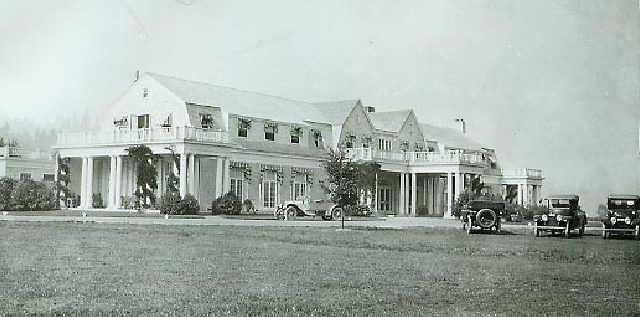
Waverley members celebrated the completion of their clubhouse during the first week of June, 1913. The old clubhouse was the site of a final party, after which some furnishings, crockery and china were moved to the new clubhouse. During the opening week, many parties, luncheons and teas were hosted by members. On Saturday, a polo match was held, pitting Waverley’s Blue and Red Teams against the Vancouver Barracks teams. During this same week, the club hosted the Oregon State Championship Tournament. During this opening week, a putting contest took place each day. The finale was schedule for Saturday, June 7, 1913 when the new clubhouse was celebrated with an opening gala. The Oregonian described the setting: “The left lower wing of the house is furnished from simple yet tasteful chandeliers hung with crystal pendants. The windows are draped with soft old rose taffeta and the floor is nothing short of a dancer’s dream. An alcove off of this forms a perfect setting for an orchestra.”
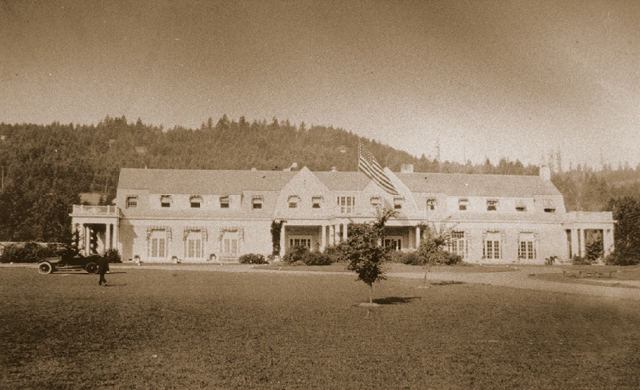
During the week of July 24-29, Waverley hosts Exhibition matches between the Chandler Egan and his Northwestern Golf Team and Chick Evans and his Middle Western Golf Team (source: Oregonian June 21, 1913)
Northwestern Golf Team | Middle Western Golf Team
H. Chandler Egan – WCC | Charles “Chick” Evans
Harry Davis – WCC | Warren K. Wood
Turnbull – WCC Professional | De Vol
A.V. Macan – Victoria | Ned Sawyer
J.S. Matterson – Victoria | Harry Legg
T.S. Lippy – Seattle | Frazier Hale
A.S. Kerry – Seattle | Phil Stanton
Jack Neville – Oakland | Fleager
On September 18, 1913 Waverley member Peter Kerr recommended a set of names for the holes of the golf course. The names persist to today, even though characteristic features in some cases have changed:
1. “Ardgour”- Ardgour was the name of the MacMaster Estate
2. “Railside”- Recognizes the proximity of the interurban railcar line that ran beside the current #7.
3. “Trap”- Treacherous bunkers gave rise to this historic name
4. “Dogwood”- Recognized the flowering trees that brighten the course each Spring
5. “Nobbly”– The Century Dictionary of 1913 defines the word as “to frustrate”.
6. “Fountain”– Named for the drinking fountain donated by member Harry Davis who played in the now historic match between Ted Ray and Harry Vardon vs. Harry Davis and Chandler Egan
7. “Park”- Comes from “Golf Park”, original name of the Garthwick subdivision
8. “Lone Pine”- The Lone Pine on #8 blew down during the Columbus Day storm in 1962
9. “Halfway”– Members were either halfway home or halfway to the 19th hole
10. “Cottage” - Cottage referred to the greenskeeper’s house, originally a Cambridge lot
11. “Kopjes”– A term used during the Boer War. It meant a hill with a flat top and steep slope.
12. “Bunker Hill”– Bunkers, dotting the hillside, awaited an errant drive
13. “Waterloo” - Rumored to have been named by an irate golfer
14. “Dinky”- Recognized the short length of the hole.
15. “Old Home”- Recognized the location of the original clubhouse near what is now the 15th green.
16. “Punchbowl”- The original design of this hold gave rise to its historic name
17. “River”- Acknowledged the fairway on this hole always ran treacherously close to the banks of the Willamette River.
18. “Home”- There is no place like home (one of the Northwest’s most recognizable finishing holes).

THE VARDON-RAY EXHIBITION MATCH OF 1913
Left to Right...Harry Davis, Harry Vardon, Chandler Egan, Ted Ray
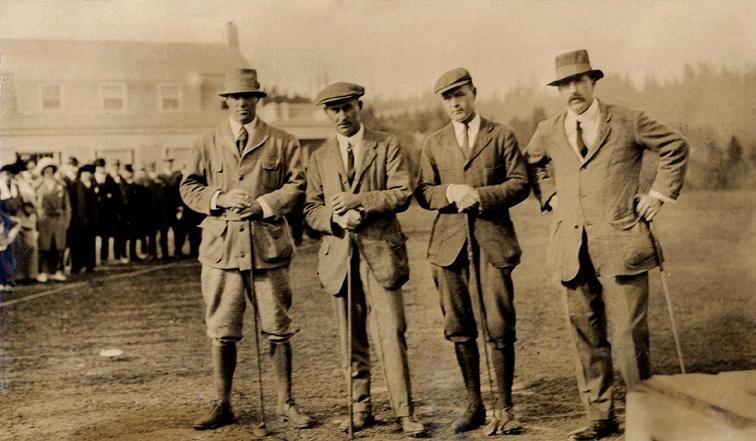 In October of 1913, arguably the two most famous golfers in the world—Harry Vardon and Ted Ray, both from the island of Jersey in Great Britain—played Harry Davis and Chandler Egan in an exhibition match at Waverley. In those days, golf professionals were modestly paid and were generally considered second-class citizens, even in the clubs where they were professionals. To augment their income, Vardon and Ray played a series of exhibition matches in the U.S. during the summer and fall of 1913.
In October of 1913, arguably the two most famous golfers in the world—Harry Vardon and Ted Ray, both from the island of Jersey in Great Britain—played Harry Davis and Chandler Egan in an exhibition match at Waverley. In those days, golf professionals were modestly paid and were generally considered second-class citizens, even in the clubs where they were professionals. To augment their income, Vardon and Ray played a series of exhibition matches in the U.S. during the summer and fall of 1913.
The match at Waverley followed shortly on the heels of the 1913 U.S. Open, played at the Country Club in Brookline, Massachusetts. That match—chronicled in Mark Frost’s book, The Greatest Game Ever Played—was won by 20 year old amateur Francis Ouimet. There was a three-way tie at the end of regulation play. Ouimet defeated Vardon and Ray in an 18-hole playoff on September 20, winning with a score of 72. Vardon was second with 77 and Ray came in third with a 78. It was widely hailed as a stunning upset over the strongly-favored Brits. Ouimet was the first amateur to win the U.S. Open.
This memorable event is commemorated annually by Waverley members who team up for a summer-long match play tournament known as “The Vardon-Ray”.
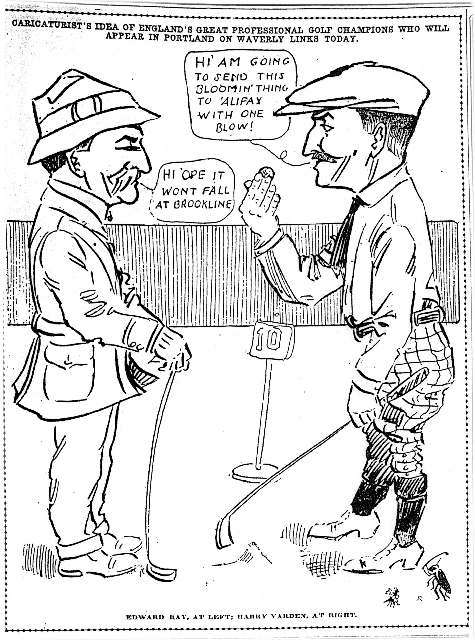

On November 20, 1913 H. Chandler Egan was unanimously elected to Honorary Membership in Waverley Country Club.
1915
With the passage of the Oregon Dry Amendment, Waverley goes “dry”. An account by a member indicates, “It seems to have set a certain feeling of gloom.”
1916
Waverley experiences a caddy strike resulting in a rule that Waverley would employ no caddy over 16 unless they still attended (school).
Individual Waverley members fund major golf course improvement. H. Chandler Egan is hired to install a drinking fountain at the 10th green and construction of 22 bunkers including..
- 2nd Hole – 1 bunker and raising back of green
- 3rd hole – three bunkers
- 4th hole – 2 bunkers
- 7th hole – 2 bunkers
- 8th hole – 1 bunker
- 12th hole – 4 bunkers
- 13th hole – 2 bunkers & enlarge 1 old one
- 15th hole – 3 bunkers
- 16th hole – 2 bunkers
- 18th hole – 2 bunkers
Out of regular funds the bunkers around the 9th green and the 12th green as well as the bunker in front of the 4th green (this bunker on Mr. Egan’s suggestion was partly filled in and made over).
1917
Waverley hosts the PNGA Tournament
Outgoing President W.W. Cotton recommends inexpensive, but warm cottages along the River which would be for rent to members
1918
In September, the Waverley Board announces the dues will be doubled.
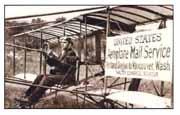
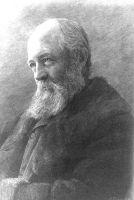
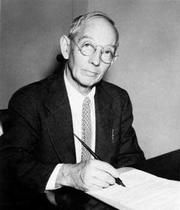

![]()


 In October of 1913, arguably the two most famous golfers in the world—Harry Vardon and Ted Ray, both from the island of Jersey in Great Britain—played Harry Davis and Chandler Egan in an exhibition match at Waverley. In those days, golf professionals were modestly paid and were generally considered second-class citizens, even in the clubs where they were professionals. To augment their income, Vardon and Ray played a series of exhibition matches in the U.S. during the summer and fall of 1913.
In October of 1913, arguably the two most famous golfers in the world—Harry Vardon and Ted Ray, both from the island of Jersey in Great Britain—played Harry Davis and Chandler Egan in an exhibition match at Waverley. In those days, golf professionals were modestly paid and were generally considered second-class citizens, even in the clubs where they were professionals. To augment their income, Vardon and Ray played a series of exhibition matches in the U.S. during the summer and fall of 1913.
![]()